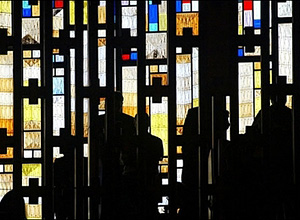 |
 |
 |
 Health & Beauty | April 2007 Health & Beauty | April 2007  
Mexican Girls Hit by 'Mass Hysteria' at Korean Nuns' School
 Agence France-Presse Agence France-Presse


| | Mexican girls studying at a strict Catholic boarding school run by a South Korean nun were to undergo psychological therapy Monday after hundreds of them were hit by a mysterious case of "mass hysteria," health officials said. (AFP/Gabriel Bouys) |
Mexican girls studying at a strict boarding school run by a South Korean nun were to undergo psychological therapy Monday after hundreds of them were hit by a mysterious case of "mass hysteria," health officials said.

The case emerged in October when two teenagers at Girls Town school near Mexico City suffered from muscle atrophy and nausea, symptoms seen in mass hysteria.

The malaise struck up to 600 of the 4,500 students at one point, and health officials determined they suffered from mass hysteria.

"We will work with the girls in specific therapy as a follow-up," Victor Manuel Torres, under secretary of epidemiology for Mexico state, told reporters Sunday. "We must investigate if it is a case of social adversity."

"So far, the diagnosis is an epidemic conversion disorder, an illness known as mass hysteria," Torres said.

About 120 girls still show some or all symptoms of mass hysteria and are still at the school, he said.

The Roman Catholic school, a free establishment for 12- to 18-year old girls from poor families run by sister Margie Cheong, has come under fire since the case came to light.

The students are only allowed two weeks of vacation a year.

Nelly Montano, a 19-year-old former student who now works at the school, said the girls can only see their parents twice a year.

"Sometimes they are sad because they can receive mail, but obviously may not answer," Montano said in a telephone interview. "Sometimes the parents write bad news, or something that worries them."

Allegations of mistreatment have also emerged, including from former teachers.

"They said some of the girls were ill because the food the nuns serve is spoiled and the water is polluted, which is false, because now inspections are better so everything we eat is cleaner," Cheong told AFP.

On Sunday, Cheong moved up this semester's parental visit by one week, to allow parents to inspect the campus in Chalco, some 50 kilometers (80 miles) outside Mexico City.

According to reports, some parents have withdrawn their girls.

"The parents become afraid and lose their heads because they are very angry and upset to see their girls this way," Cheong said.

Cheong denies reports saying the illness could result from the school's strict discipline and punishments, said to include forcing the girls to go barefoot or stand in cow dung.

The nun expressed dismay at the strange epidemic that has hit her school.

"What stuns us - really shocks us - is that they cannot walk," she said. "Doctors who have done the analysis say that they are imitating each other, (that) it is psychological."

The Sisters of Mary, a Roman Catholic order from South Korea, founded the secondary school to teach poor girls dressmaking before sending them to factories to work for short periods.

In October 2006, two girls showed the symptoms. Four months later, 200 girls were affected, and 400 more in March.

Another concern is the school's use of non-Western medicine, as one girl, now an oncologic nurse, told Televisa television.

She showed the network what she said were burns inflicted to eliminate swelled ganglia in her throat by what the nuns called a Korean doctor.

"Yes, that was a technique that we used to help 10 girls," Cheong said, "It was not to hurt them."

Cheong also pointed out that besides the ill girls, 3,000 others were in perfect health. | 
 | |
 |



